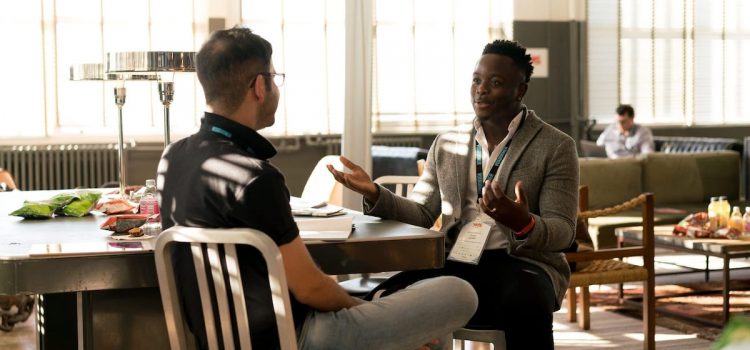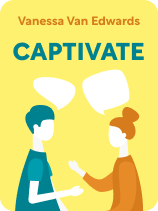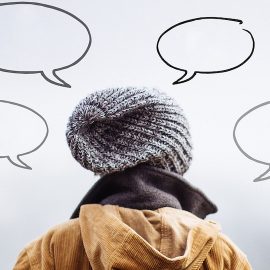

This article is an excerpt from the Shortform book guide to "Captivate" by Vanessa Van Edwards. Shortform has the world's best summaries and analyses of books you should be reading.
Like this article? Sign up for a free trial here.
What are effective ways to move past small talk? How can you craft engaging stories and ask better questions?
In Captivate, Vanessa Van Edwards discusses how to make the most of social interactions, getting people to like and remember you, and ultimately building deep relationships. Good conversation is critical. You can learn how to be a good conversationalist by being inquisitive and showing interest in others.
Keep reading for practical tips on being a curious and interesting conversationalist.
Be a Curious Conversationalist
Often, connections begin with a memorable conversation. Van Edwards’s advice on how to be a good conversationalist involves grabbing people’s attention and getting them to talk about themselves by initiating unusual conversations and telling stories that are out of the ordinary.
Initiate Thought-Provoking Conversations
Van Edwards asserts that to make others like and remember you, you have to break out of the boring small talk mold and ignite interesting conversations that push people to think of new and different things. She explains that we’re most compelling to others when we’re unscripted because novelty triggers activity in the part of the brain responsible for memory and learning and is linked to dopamine pathways that arouse pleasure and fuel interest.
To start novel conversations, you can ask questions that 1) people don’t expect, shake them out of their rut, and 2) engage people by prompting them to talk about subjects they love and are excited to talk about. For example, “What’s the most exciting thing that happened to you today?” or “What’s the one thing you’re most looking forward to doing this year?”
(Shortform note: Van Edwards recommends using novel conversations to be memorable, but, but some research suggests that we prefer familiar topics to new ones because of the “novelty penalty.” This is a phenomenon in which the listener doesn’t have enough base knowledge or personal experience in the topic to be interested, so they mentally “check out” during the conversation. This is why a seemingly exciting topic, like volunteering abroad, might not actually spark an engaging conversation unless the listener has something to add.)
Tie Your Story Back to the Listener
Van Edwards says that telling interesting stories will enable you to deepen your engagement and forge connections with others because it lights up the same regions of your brains.
She says that great stories are no more than two to three minutes long and have three parts:
- A hook that grabs people’s attention immediately
- A problem or challenge that has to be overcome
- Descriptive, stimulating words
She recommends the following three-pronged approach for introducing and using stories to engage and fuel further conversation with people:
- Build off of a frequently discussed subject (for example, the news, weather, a TV show).
- Tell a funny or quirky story related to that subject. If you can’t think of one, you can use a story you heard somewhere else.
- End with a transition sentence or question that connects your story back to the person you’re talking with to actively engage them and keep the conversation going. For example: “But enough about my most embarrassing childhood memory, tell me about yours!”
Van Edwards suggests having a stash of stories and questions on hand for different subjects that typically come up in casual conversation, such as current events, travel, or jobs.
| When Telling Stories, Know Your Audience Van Edwards lists “current events” as one of many subjects you could use as a launching pad to tell a story, but there’s reason to be mindful of which subjects you tell stories about in different settings. For example, some people suggest that you steer clear of talking politics at work to avoid creating divisions that can hurt otherwise productive relationships, lead to a hostile work environment, and isolate people. You may also want to keep stories about politics to yourself if you work for a private company, where you have fewer free speech protections. Conversations that begin as seemingly harmless political discussions can be (and be perceived as) harassment, discrimination, and other federal workplace civil rights violations. With this in mind, it’s probably best to pull stories from more lighthearted and universally appealing topics when at work. |
Be Interested to Be Interesting
You’ve grabbed people’s attention and gotten a conversation going. Next, you need to show that you find them compelling.
Van Edwards asserts that, when you’re genuinely interested in other people, they find you interesting because of the “reciprocity effect,” a phenomenon where we like being with people who clearly like us and we mirror the positive behavior they display toward us.
Van Edwards recommends putting the reciprocity effect into action by interacting with people in ways you’d like them to interact with you.
The 3 Es: Engage, Encourage, and Elevate
Van Edwards states that engaging people in conversation, encouraging them to talk about themselves, and elevating them by boosting their strong points makes them feel good, which leads them to like and remember you. She cites research showing that talking about ourselves triggers the release of dopamine, which gives us pleasure and triggers our memory. Furthermore, receiving compliments improves our self-image. She says you can reinforce the positive engage, encourage, and elevate loop by:
- Asking people questions that get them to talk about themselves
- Being an active listener
- Pointing out people’s positive qualities, showing enthusiasm when they’re excited, and bragging about them when you introduce them to others
| Optimize the 3 Es The 3 Es provide a framework for sparking a lively conversation and getting people to like you. With some additional advice, you can fine-tune this framework and find even more success. First, start with a compliment. Not only do people enjoy answering questions about themselves, but research has also found that the order in which you ask questions can lead them to have more positive feelings and engagement. When you lead with a question that highlights a positive aspect of the listener’s life and then follow up with a more general question, the brain of the person answering carries over the good feeling from the first question to the second. For example, if you ask someone, “How did you get so good at your job?” and then follow up with, “What do you think makes a customer open their marketing emails?” you are sure to get a more detailed and enthusiastic response to the second question. Second, listen actively. How you respond to the answers people give is equally important to asking great questions. You can be an active listener by making a concerted effort to hear, understand, and respond thoughtfully to information that people share with you: • Focus on the person talking to you by putting down your cell phone and turning off the TV. • Demonstrate that you’re listening by making eye contact, nodding, and not interrupting. • Paraphrase or summarize the main points to show that you understand what they’ve shared with you. • Ask probing questions to get people to explain things in greater depth. • Show empathy and validate people by saying things like, “Yes, that makes sense,” or “That sounds really hard. How can I help?” Third, lift them up. In addition to validating people by being an active listener, you can raise them up, which makes them feel better about themselves and you. When you praise people, you trigger a phenomenon known as “spontaneous trait transference,” which leads them to associate you with the positive adjectives you use to describe them—even when you don’t know them well. Introduce someone you just met as “warm and funny” to other people, and they’ll likely feel warmth for you. |
Highlight Shared Connections
As is true with highlighting people’s best qualities, finding your similarities with others makes you more appealing to them. Van Edwards cites research showing that we like and get along more easily with people who agree and share common interests with us. You can take the following steps to identify and illuminate your similarities with others:
- Find out if you share friends and interests or are engaged in any of the same online or in-person groups, like a book club or gym class.
- Ask why the friend, interest, or group you have in common matters to the other person. She suggests asking “why?” repeatedly as a way to probe deeper and enrich your understanding of the conversation.
- Offer to help or be a resource for the other person if 1) you feel you’ve developed a genuine connection with them and 2) you have something useful you can provide them.
(Shortform note: Extensive research finds that we’re more attracted to people who are like us. A review of 313 studies with more than 35,000 participants found that similarity strongly predicted attraction at the onset of relationships. However, some psychologists contend that being too much alike can curb our attraction to others by stunting our need for personal growth.)

———End of Preview———
Like what you just read? Read the rest of the world's best book summary and analysis of Vanessa Van Edwards's "Captivate" at Shortform.
Here's what you'll find in our full Captivate summary:
- How socially awkward people can become social superstars
- How to make yourself likable and memorable
- Methods to establish and improve relationships with others






